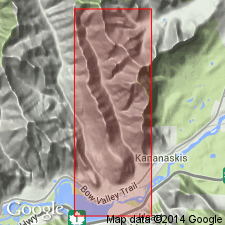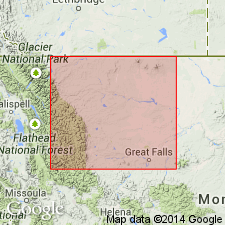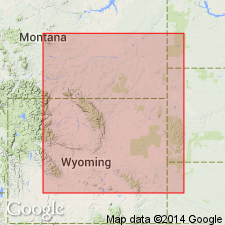
- Usage in publication:
-
- Exshaw shale
- Modifications:
-
- Named
- Dominant lithology:
-
- Shale
Summary:
A black shale determined to be Devonian age that was included in the Banff formation of Mississippian age is removed from the Banff and named Exshaw formation. Place name derived from the name of a town of that name in the Bow gap, [Alberta, Canada]. No type locality designated. Unconformably overlies the Upper and Middle? Devonian Minnewanka formation. The uppermost bed of the Minnewanka is pyritized and contains broken fragments of DINICHTYS bones. Varies greatly in thickness, [though no thicknesses stated]. Correlated with Three Forks shale of MT. Both formations represent the uppermost Devonian; both formations overlie an Upper Devonian limestone carrying SPIRIFER WHITNEYI; both formations overlain by formations with a Kinderhook fauna.
Source: GNU records (USGS DDS-6; Denver GNULEX).

- Usage in publication:
-
- Exshaw Formation*
- Modifications:
-
- Principal reference
- Adopted
- Dominant lithology:
-
- Limestone
- Shale
- Sandstone
- AAPG geologic province:
-
- Sweetgrass arch
Summary:
Pg. A5, A39-A43. Exshaw Formation adopted by the USGS. Extended into Montana subsurface (Glacier, Liberty, Pondera, Teton, and Toole Counties). Comprises (ascending) a sandstone member, 0.17 feet; a shale member, 31 feet; and a limestone member, 37 feet. Total thickness 68.17 feet. Unconformably overlies Upper Devonian Palliser Formation and underlies with gradational contact Lower Mississippian Banff Formation. Correlated with Sappington Member of Three Forks Formation and Bakken Formation. Fossiliferous. Age is considered Late Devonian and Early Mississippian.
Type locality: in Jura Creek, 1 mi east of Exshaw and 2 mi north of highway between Calgary and Banff, Alberta, Canada (Sandberg, 1967).
[Type section (corrected): in Jura Creek, 3.2 km (2 mi) north of Exshaw, Alberta; Lat. 51 deg. 05 min. 29 sec. N., Long. 115 deg. 09 min. 29 sec. W.; NTS 82O/3; eastern Rocky Mountain Front Ranges, southwestern Alberta (Lexicon of Canadian Geologic Units (accessed March 26, 2012); see also Richards and others, 1994, Carbonif. strata, chap. 14, Geol. Atlas Western Canada Sed. Basin; available online: http://www.ags.gov.ab.ca/publications/wcsb_atlas/a_ch14/ch_14.html).]
Source: Publication.

- Usage in publication:
-
- Exshaw Formation*
- Modifications:
-
- Age modified
- AAPG geologic province:
-
- Sweetgrass arch
Summary:
Assigned to base of author's stratigraphic sequence 4 (Kinderhookian to lower Meramecian). [Areal extent of Exshaw not discussed; presumably is present in Sweetgrass arch of central MT.] Exshaw is name used when upper dark shale unit of Bakken Formation is missing or not distinguishable. Exshaw is at least partially equivalent to unnamed basal clastic unit which is time transgressive throughout its areal extent in Powder River basin study area and which is also at least partially equivalent to Cottonwood Canyon Member of Madison or Lodgepole Limestones, Englewood Formation, Paine Member of Lodgepole, Leatham Formation, Sappington Member of Three Forks Formation, lower part of Guernsey Formation, and others. Assigned Kinderhookian age. Devonian age assigned to unit by some other workers was based on equivocal Devonian-age conodonts collected from probable pre-Exshaw basal lag deposits.
Source: GNU records (USGS DDS-6; Denver GNULEX).
For more information, please contact Nancy Stamm, Geologic Names Committee Secretary.
Asterisk (*) indicates published by U.S. Geological Survey authors.
"No current usage" (†) implies that a name has been abandoned or has fallen into disuse. Former usage and, if known, replacement name given in parentheses ( ).
Slash (/) indicates name conflicts with nomenclatural guidelines (CSN, 1933; ACSN, 1961, 1970; NACSN, 1983, 2005, 2021). May be explained within brackets ([ ]).

